Lost wax casting is an intricate technique widely adopted in the jewelry industry.
With decades of expertise, rest assured that this guide is rooted in professional knowledge and firsthand experience.
After thorough research, I’ve found that lost wax casting offers unparalleled precision and flexibility, making it essential for jewelry designers and manufacturers.
Within this guide, we’ll delve into the nuances of this ancient process, understanding its practical applications in today’s dynamic jewelry market.
So, let’s get started and illuminate the world of lost wax casting. Read on!
1. Understanding Lost Wax Casting: The Basics
Lost wax casting, known in some circles as investment casting, is a time-honored method for producing a range of objects in various metals, including gold, silver, brass, or bronze. As noted by Formlabs, it allows for the creation of items ranging from simple to intricate through the casting of an original model or pattern.
In this method, a wax model is covered in a hard shell. When heated, the wax melts and drains, leaving a hollow mold. Molten metal is then poured in, solidifying to replicate the original wax design. Having practiced this art at Rexjewel, I can vouch for its effectiveness. The result is a precise and detailed replica of the original design, particularly beneficial for intricate jewelry pieces.
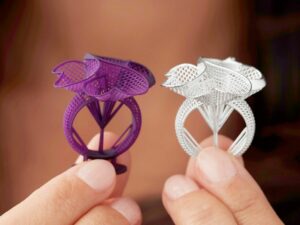
2. Benefits of Using Lost Wax Casting in Jewelry Making
Lost wax casting, a historic method dating back to ancient times, has stood the test of time, proving to be an invaluable technique in the jewelry making industry. It allows artists to create intricate designs with a finesse that is hard to achieve with other methods. Here are the benefits that make lost wax casting an excellent choice for jewelry creation:
- High Precision: Lost wax casting allows for a high level of precision, creating intricate and detailed designs that might be impossible through other methods.
- Versatility of Designs: It enables artists to experiment with a wide range of designs, from simple to highly complex patterns without compromising the quality of the final piece.
- Material Conservation: This method often results in less waste compared to other casting processes, making it a more economical choice for jewelry makers.
- Smooth Finishes: Jewelry pieces created through lost wax casting generally have smoother finishes, reducing the amount of post-casting work required to finalize a piece.
- Bulk Production: It facilitates the efficient production of multiple copies of a piece, maintaining a consistent quality throughout the batch.
- Cost-Effective: Despite its detailed process, lost wax casting can be a cost-effective method, especially when producing many units of the same design.
- Complex Hollow Designs: This method allows for the creation of complex hollow designs that are not only intricate but also lighter, offering a comfortable option for wearers.
- Customization: It offers the flexibility to create customized jewelry pieces that cater to individual preferences and styles.
- Improved Aesthetics: Due to the high level of detail achievable, jewelry pieces crafted through this method often feature improved aesthetics, enhancing the perceived value and attractiveness.
- Historical Connection: Utilizing a method with ancient origins provides a deep historical and cultural connection, adding a layer of richness and story to each piece.
We see here that the lost wax casting technique stands as a cornerstone in the jewelry-making industry, offering a blend of precision, versatility, and historical richness that contributes to the creation of truly remarkable pieces.
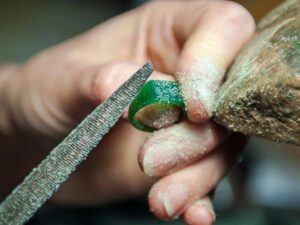
3. Materials and Tools Used
Embarking on a jewelry project through lost wax casting involves utilizing a specific set of materials and tools that aid in crafting detailed and exquisite pieces. These materials and tools form the backbone of the crafting process, ensuring precision and quality. Below are the essential components that play a pivotal role in lost wax casting for jewelry:
- Wax Patterns:These are intricately carved or molded forms from which the final jewelry piece is cast; they serve as the first step in crafting detailed designs.
- Investment Powder:A special kind of plaster used to create the mold around the wax pattern, which later holds the molten metal during the casting process.
- Burnout Kiln:This is a specialized oven used to eliminate the wax from the mold, leaving behind a cavity in the exact shape of the desired jewelry piece.
- Casting Flask:A cylindrical container where the investment mold is placed during the burnout and casting process, helping maintain the shape and integrity of the mold.
- Centrifugal or Vacuum Casting Machine:These machines facilitate the smooth pouring of molten metal into the molds, using either centrifugal force or a vacuum to ensure detailed and defect-free casting.
- Metal Alloys:Different types of metal alloys like gold, silver, or bronze are used as the raw material, which gets melted and poured into investment molds to create jewelry pieces.
- Sprue Bases:These are platforms that hold the wax pattern during the investing process, ensuring stability and facilitating a smooth transition into the mold.
- Wax Carving Tools:These tools assist in sculpting and carving the wax patterns, allowing for detailed and precise designs to be created before the casting process.
- Crucible:A container, often made of graphite or ceramic, used to melt the metal alloys at high temperatures, facilitating a smooth pouring process into the molds.
- Finishing Tools:After the casting, various tools are used for finishing the jewelry piece, including files, sandpapers, and polishing equipment to refine and enhance the final look.
Having a set of specialized materials and tools at hand is vital in lost wax casting, ensuring that every crafted piece is a testament to precision, artistry, and quality.
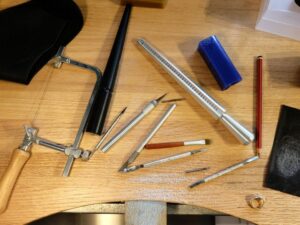
4. The Step-by-Step Process of Lost Wax Casting
In the realm of jewelry manufacturing, lost wax casting stands as a highly favored technique, especially among business entities aiming for precision and excellence in their products. This method allows businesses to craft intricate pieces efficiently, which meets the sophisticated demands of today’s market. Below, we delve into the step-by-step process of lost wax casting:
Step#1 Wax Pattern Creation
Initially, the journey begins with the crafting of a precise wax model, which acts as the blueprint for the final jewelry piece. For example, utilizing specialized tools, artisans meticulously carve intricate patterns and designs into the wax, forming a model that carries every detail desired in the finished product. This stage requires a deft hand and an eye for detail, ensuring that the prototype embodies perfection and finesse.
Step#2 Mold Preparation
Following the wax pattern creation, the next pivotal step is preparing the mold using investment powder. The wax model is surrounded by a mixture of investment powder and water, forming a sturdy casing that captures every nuance of the design. This phase demands precision, as the mixture must be prepared to exact specifications to ensure a flawless cast.
Step#3 Burnout Process
Upon the solidification of the mold, it undergoes a burnout process in a specialized kiln. Here, the mold is subjected to escalating temperatures that methodically eliminate the wax, leaving behind a hollow cavity that retains the intricate details from the wax model. This procedure is critical, as it readies the mold for the reception of molten metal, setting the stage for the manifestation of the envisioned design.
Step#4 Metal Casting
As the mold reaches an optimal condition post-burnout, the stage is set for the casting of molten metal. Next, chosen metal alloys are melted to a liquid state in a crucible, before being poured or injected into the vacant mold, adopting the form of the original wax pattern. I have seen at Rexjewel that this moment is where the vision starts materializing, gradually shaping into a tangible product that embodies the detail of wax patterns.
Step#5 Finishing and Polishing
The final stage in the lost wax casting process is finishing and polishing, where the cast piece is liberated from the mold and undergoes a series of refinements. Through the use of various tools and equipment, the piece is filed, sanded, and polished to a high sheen, showcasing the intricate details and craftsmanship that went into its creation.
This phase transforms the raw cast into a piece of art, ready to mesmerize clients with its brilliance and detail. For example, in a B2B setting, offering finishing services that highlight precision and expertise can elevate the product value, securing a foothold in the competitive market by guaranteeing pieces that resonate with beauty and excellence.
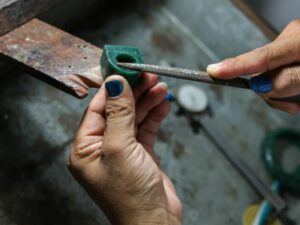
5. Lost Wax Casting vs. Other Jewelry Making Techniques
Two prevalent options include the time-tested lost wax casting and other diverse jewelry making techniques, each coming with its own set of merits and demerits. Here, we outline a comparative analysis, presenting a view of the advantages and disadvantages of both approaches:
Lost Wax Casting
Advantages:
- Precision and Detail: Lost wax casting allows for the creation of intricate and detailed designs, which might be difficult to achieve through other methods.
- Cost-Effective for Mass Production:This method proves to be economical when manufacturing large quantities of identical pieces.
- Material Versatility:It provides the flexibility to work with a wide variety of metals, broadening the range of products that can be created.
- Customization:Allows for high levels of customization, enabling the crafting of unique, bespoke jewelry pieces.
- Consistency:Offers consistency in production, ensuring that each piece maintains uniform quality and detail.
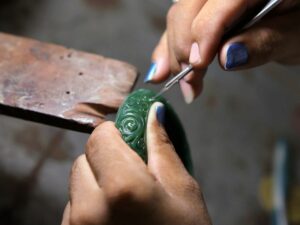
Disadvantages:
- Initial Setup Cost:The method can incur high initial setup costs, especially when crafting complex designs.
- Time-Consuming:The multi-step process can be time-consuming, particularly for small batches.
- Wax Model Limitations:The wax models are delicate and susceptible to damage during the initial phases.
- Material Waste: This can result in material waste, especially if errors occur during the casting phase.
- Skill Dependent:The process is heavily dependent on skilled artisans, particularly in the wax model creation stage.
Other Jewelry Making Techniques
Advantages:
- Direct Crafting:Many techniques allow for direct crafting, offering a hands-on approach to jewelry making.
- Lower Setup Costs:Generally have lower initial setup costs compared to lost wax casting.
- Creativity and Experimentation:Allows artisans the freedom to experiment and explore diverse designs and styles.
- Personal Touch:Handcrafted pieces can embody a personal touch, showcasing the artisan’s individual craftsmanship.
- Quick Prototyping:Some methods enable quick prototyping, facilitating rapid product development and adjustments.
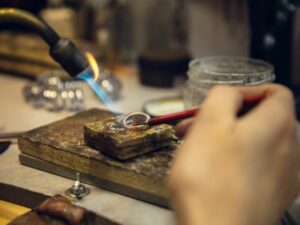
Disadvantages:
- Limited Complexity:Many techniques might limit the complexity and intricacy of the designs achievable.
- Labor Intensive:Handcrafted methods can be labor-intensive, potentially increasing production time and costs.
- Inconsistency:These techniques might yield inconsistent results, especially when crafting multiple identical pieces.
- Material Restrictions:Certain methods might restrict the types of materials that can be effectively used.
- Skill Barrier:Like lost wax casting, these techniques often require skilled artisans to produce high-quality pieces.
As businesses venture into the realm of jewelry manufacturing, understanding the nuances, advantages, and drawbacks of lost wax casting compared to other techniques can pave the way for informed, strategic decision-making, fostering a production line that resonates with quality, efficiency, and innovation.
6. Challenges and Common Mistakes
Navigating through the intricate process of lost wax casting in jewelry manufacturing is both an art and a science, encompassing a range of steps that demand precision and expertise. Being cognizant of these potential pitfalls is vital for businesses aiming to deliver high-quality products consistently. Here we outline five challenges and common mistakes encountered in lost wax casting:
Inadequate Wax Pattern Preparation
The creation of the wax pattern is the first and most crucial step in the lost wax casting process, and errors at this stage can lead to a series of complications down the line. Often, inexperienced artisans might overlook minute details, resulting in patterns that do not align with the desired specifications. Rushing through this phase might lead to improperly formed patterns, which directly influence the final product’s quality.
Investment Mold Cracks
Investment molds are fundamental to achieving detailed and intricate designs in the final jewelry piece. However, cracks in the mold can occur due to various reasons, including rapid drying or inconsistencies in the mixture. These cracks can lead to flawed castings, with molten metal potentially seeping into unwanted areas.
A faulty mold can be the source of financial and material wastage, hindering the smooth flow of the production process.
Incomplete Burnout Cycle
The burnout cycle is a critical phase where the wax is eliminated from the investment mold, leaving behind a perfect cavity for the molten metal. An incomplete burnout cycle, resulting from insufficient time or inadequate temperatures, can leave remnants of wax within the mold. This not only affects the quality of the cast but can also cause defects and inclusions in the final product.
Improper Metal Pouring
The metal pouring stage is where the envisioned design starts taking a tangible form, and any mistakes during this process can be detrimental. Sometimes, improper pouring techniques or incorrect temperatures can lead to defects such as porosity or incomplete fills. These errors often result in a finished product that falls short of the desired quality standards, necessitating costly redo’s.
Inefficient Finishing Techniques
Once the casting process is complete, the finishing stage is where the piece undergoes refining to enhance its visual appeal. However, inefficient finishing techniques, including aggressive polishing or inadequate cleaning, can mar the intricate details of the jewelry piece. Excessive finishing can sometimes remove the fine details that were carefully crafted in the wax pattern, diminishing the piece’s overall aesthetic value.
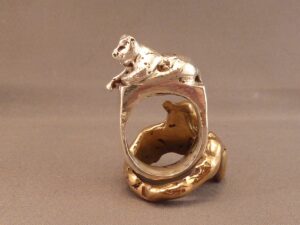
7. 5 Tips for Successful Lost Wax Casting
Lost wax casting, also known as investment casting, is a time-honored technique primarily used for creating detailed metal objects, often in jewelry and industrial applications. Here are five tips to ensure successful lost wax casting:
#1 Investing in Skilled Artisans
One of the cornerstone tips for a successful venture in lost wax casting is the investment in skilled artisans who embody both experience and craftsmanship. These individuals have the ability to craft exquisite wax patterns, which are the blueprint for your final product, with a keen eye for detail and precision. Their expertise forms the foundation of the entire process, ensuring the initial steps are executed flawlessly.
#2 Quality Control at Every Phase
Implementing stringent quality control measures at every phase of the process can drastically minimize errors and enhance the final product’s quality. This involves conducting meticulous checks at each stage, from wax pattern creation to the final polishing, ensuring adherence to predefined standards and specifications. Consistent monitoring helps in the early detection of potential issues, allowing for timely corrections.
| Phase |
Quality Control Actions |
Why It Matters |
| Model Making |
Inspect the initial wax model for accurate design representation and details. Ensure even thickness to prevent casting issues. |
A flawed wax model will result in a flawed final product. |
| Sprue Attachment |
Ensure secure and correct placement of sprues for even metal flow. Verify sprue thickness to match casting requirements. |
Incorrect sprue attachment can lead to incomplete casting or metal porosity. |
| Investment |
Mix the investment under controlled conditions to prevent air bubbles. Pour carefully to avoid trapping air. |
Air bubbles or flaws in the investment mold can lead to casting defects. |
| Burnout Cycle |
Calibrate oven for accurate temperatures. Follow recommended burnout schedule closely. |
Ensures complete wax elimination and proper mold preparation for casting. |
| Metal Preparation |
Verify metal purity and alloy composition. Ensure the melt reaches the correct temperature. |
Ensures the final product has the desired material properties and appearance. |
| Casting |
Monitor equipment for consistent pressure or vacuum. Pour metal steadily and ensure the mold fills completely. |
Prevents incomplete casting, air pockets, or other flaws in the final piece. |
| Quenching & Cleaning |
Wait for the appropriate cooling time before quenching. Use recommended cleaning methods to remove investment residue. |
Protects the integrity of the piece and ensures all residues are effectively removed. |
| Removal of Sprues |
Carefully cut or grind away sprues to avoid damaging the piece. Inspect for any rough spots or marks. |
Ensures a clean and smooth finish, preparing the piece for final detailing and polishing. |
| Final Inspection |
Examine the piece for any casting flaws, imperfections, or missed details. Test for desired hardness or material properties. |
Quality assurance ensures that only pieces that meet the brand’s standards move forward to the final stages or sale. |
#3 Investment Molds
Ensuring the optimal preparation of investment molds stands as a pivotal aspect that can influence the success of the lost wax casting process. This encompasses selecting the right materials and adhering to the correct preparation techniques, which culminate in molds that are both durable and capable of capturing intricate details. A well-prepared mold is a prerequisite for a successful casting.
#4 Precision in Metal Casting
Achieving precision in the metal casting stage is a critical aspect that can significantly influence the outcome of the final product. This necessitates the utilization of advanced machinery and techniques that ensure a smooth and flawless pour of molten metal into the molds. Expertise in handling the details of this stage, including temperature control and pouring techniques, can mitigate the occurrence of defects like porosity.
#5 Mastery in Finishing Techniques
The finishing stage serves as the final frontier in the lost wax casting process, where the crafted piece undergoes a series of refinements to enhance its visual allure. Mastering the finishing techniques, which involve meticulous polishing and refining, can accentuate the details and elevate the piece’s overall beauty.
This final touch can make or break the perceived value of the product, thus requiring a balanced approach that enhances without eroding the intricate details.
Dive Deeper Into Our Resources
For some insightful reads, we’ve curated a list of recommended articles just for you:
Still haven’t found what you’re looking for? Don’t hesitate to contact us. We’re available around the clock to assist you.
Conclusion
In this insightful exploration, we peeled back the layers of the intriguing world of lost wax casting for jewelry, offering a comprehensive deep dive into its complexities and variation.
From critical processes to potential challenges, a wealth of opportunities awaits. Rexjewel, a renowned and trusted jewelry manufacturer, stands as a light of expertise in this field. For businesses seeking insights, feel free to contact us without hesitation, and let’s embark on crafting exquisite jewelry pieces together.







